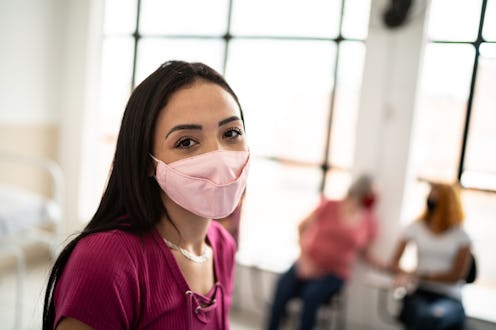Health
Doctors Explain How Long You'll Be Wearing Your Face Mask
Expect to wear them in some places for a while.

By this point, it’s as natural to grab your COVID face mask as it is to pocket your keys and wallet when you leave your home. Even so, it was over a year ago when you could go grocery shopping or see your friends without having to even think about covering your nose and mouth, which is why you might be wondering how long you will wear face masks now that vaccines are rolling out.
Of course, wearing your mask is one of the most effective strategies to curb the spread of the virus, according to Centers for Disease Control and Prevention (CDC). As more and more people get vaccinated, however, cautionary guidelines shift — now fully vaccinated folks can safely hang out with each other indoors without masks, according to a CDC report released in early March. But the return to life as you knew it isn’t a sprint, it’s a marathon, says Dr. Jennifer Pisano, MD, an infectious disease doctor at the University of Chicago. The truth is: Mask wearing and other precautions won’t disappear overnight, since mass vaccination will take time.
Now that there’s a light at the end of the pandemic tunnel, though — when exactly can you expect to safely go mask-free in public? Here, doctors explain the potential timeline of how long you’ll need to wear face masks, and why this probably won’t be the last you see of them (though not in the way that you think).
Mask Wearing Depends On Herd Immunity
While it’s hard to give an exact date for when you might be able to ditch your mask entirely (this being unprecedented times and all), one helpful benchmark is reaching herd immunity, according to Dr. Erika Schwartz, MD, a disease prevention specialist. Herd immunity is achieved when around 70% of the population has either been vaccinated or has antibodies from surviving the virus, says Pisano. Once the majority of people are protected, the virus has a harder time spreading. For a reference, as of mid-March, just about 12% of the American population is fully vaccinated, according to data from the CDC.
Fortunately, the vaccine rollout is steadily progressing at about 2 million doses per day, says Pisano. At that rate, herd immunity could potentially happen by summer, adds Schwartz. But factors like variants in the virus could set the timeline back depending on how protective vaccines are against new strains and how quickly they spread, says Pisano. Like most things involving COVID, there’s no sure-fire answer: In an interview with CNN, Dr. Anthony Fauci, director of the U.S. National Institute of Allergy and Infectious Diseases, predicted that you might continue taking some level of COVID precaution into 2022.
Mask Wearing Will Depend On The Situation
Nonetheless, you can probably count on shedding your mask to some extent over the coming months, says Pisano. For now, it’s safe to go mask-free with other vaccinated people. At this point, that might mean that you’re only able to ditch your mask at one other household where everyone has gotten their shots. But as more people get the vaccine and guidelines continue to update, those mask-free gatherings can likely get larger and larger, says Pisano. In general, she sees mask mandates first easing up in places where you have more control over your environment and who's around you, like in homes.
That said, don’t forget to use common sense, says Schwartz. Vaccinated people can still spread the virus to the unvaccinated, who could go on to get a severe or deadly case of COVID. “In public spaces like hospitals and schools, social distancing will start to decrease first,” Pisano tells Bustle. “So masking is probably going to outlast a lot of the other layers of mitigation.” Wearing your mask in those settings will help keep everybody safe even as social distancing declines.
You Might Have To Mask On And Off
Once the time comes where you’re free to wear masks in more spaces, remember that restrictions can always come back, Pisano points out. There may be smaller or seasonal outbreaks in the months and years to come, and widespread masking can help keep those flare-ups under control.
There’s also still a lot to learn about vaccines. “We don’t know how long immunity lasts,” Schwartz tells Bustle. “So if you're going to be in a crowded space, why not wear a mask?”
Masking Might Be Here To Stay
Even after the pandemic ends, masks might be a mainstay in flu seasons to come, says Pisano. After all, if you could dodge flus, colds, and seasonal COVID, why wouldn’t you? So while mask requirements may be a thing of the past after the pandemic ends, you might not have seen the last of masking — and for good reason: It works. “People will hopefully wear masks when they are in situations where they can protect themselves and others,” says Schwartz. “The other lesson that I hope is learned is that when you're sick, just stay home.”
Studies referenced:
Burra, P. (2021). Temperature and Latitude Correlate with SARS-CoV-2 Epidemiological Variables but not with Genomic Change Worldwide. Evolutionary Bioinformatics, https://journals.sagepub.com/doi/10.1177/1176934321989695
MacIntyre, C. (2020). A rapid systematic review of the efficacy of face masks and respirators against coronaviruses and other respiratory transmissible viruses for the community, healthcare workers and sick patients. International Journal of Nursing Studies, https://www.ncbi.nlm.nih.gov/pmc/articles/PMC7191274/
Randolph, H. (2020). Herd Immunity: Understanding COVID-19. Immunity, https://www.ncbi.nlm.nih.gov/pmc/articles/PMC7236739/
Experts:
Dr. Jennifer Pisano, MD, an infectious disease doctor at the University of Chicago
Dr. Erika Schwartz, MD, a New York-based internist who specializes in disease prevention
This article was originally published on